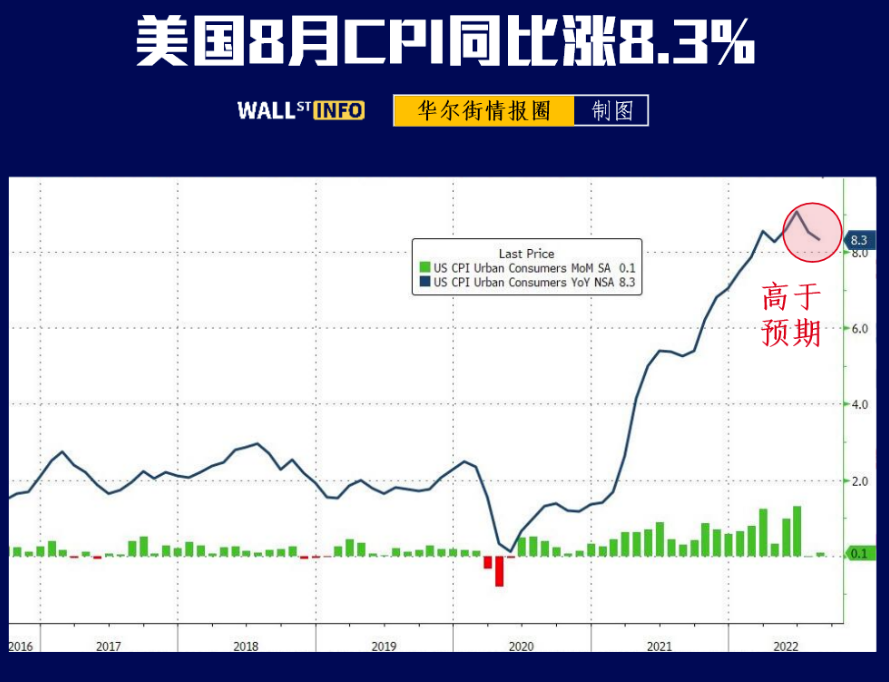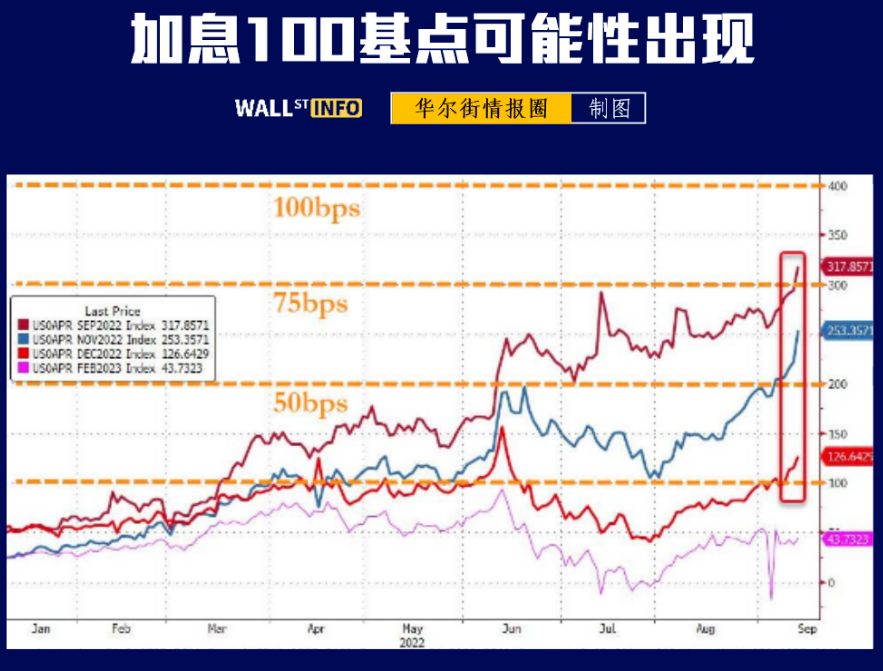Traders keep an eye on the screen before CPI data is released
--From stocks and bonds to oil and gold, investors have suffered a tragic sell-off.
This is a day that surprises the world.
1. The CPI of the United States rose more than expected in August(As expected, the drop in oil prices has led to a sharp decline in CPI.)
In August, CPI rose by 8.3% year-on-year (the market expected 8.10%, compared with the previous value of 8.5%), which is the 27th consecutive month that inflation has risen.
Key data:
(The Fed's preferred indicator) In August, the core CPI excluding food and energy in the United States rose by 0.6% month-on-month, expected to rise by 0.3% (twice as much as expected), 6.3% year-on-year and expected to rise by 6.10%.
The two most volatile factors in the CPI data, the US CPI energy price fell by 5.0% and food price rose by 0.8% in August (behind the scenes, energy price is falling, while housing cost is rising).
Housing costs rose by 0.7% month-on-month and 6.2% year-on-year, both of which were the highest levels since the beginning of 1990.
This is a report that all Fed officials pay attention to-this report confirms that fighting inflation is not an easy task, and many people misjudge the stickiness of high inflation. The Fed will remain hawkish for a long time until the economic recession.
2. The market expects the Fed to raise interest rates beyond expectations
In September, there may be bolder actions than 75 basis points, and the market has already expected the Federal Reserve to raise interest rates by 100 basis points at a time-CME's market-based FedWatch tool shows that the probability of raising interest rates by 100 basis points is 20%, which is higher than zero before the CPI was released in August.
This data has upset the market's original expectation of raising interest rates, and investors recalculate their expectations of monetary policy.
First, there is a lock in at least 75 basis points of interest rate increase in September (the possibility of raising interest rate by 50 basis points has completely disappeared), and there is an expectation of raising interest rate by 100 basis points. Although this is only the idea of a few people, this possibility is real.
Second, the market's bets on raising interest rates by 75 basis points in November and 50 basis points in December have risen (the market originally expected to raise interest rates by 50 basis points in November and 25 basis points in December).
Third, it is expected that the end rate of this interest rate hike cycle will peak at around 4.3% (previously 4%), and the interest rate hike cycle may last until the beginning of next year (previously expected to end the interest rate hike by the end of this year)
Overall, raising rates will take longer, with higher rates and more damage to the economy.
For investors, it is especially important to be careful that "the possibility of raising interest rates by 100 basis points is in sight", that is to say, "the consensus expectation of raising interest rates by 75 basis points" is cracked, and the Federal Reserve is likely to release a signal through the media before September 22, giving some hints about whether to raise interest rates by 100 basis points or 75 basis points in September. If the Fed believes the market needs shock and awe to lower inflation expectations, it is likely to raise interest rates by 100 basis points in September.
3. The stock market fell sharply beyond expectations
The expectation of raising interest rates by 100 basis points shook the stock market and investors panicked.
Before this data, the US stock market had been rising for four consecutive days. Originally, some analysts thought that the CPI data in August would be "exhausted" and bet that the stock market would continue to rise. But the truth is that the idea of peaking inflation has failed, and the possibility of a soft landing of the economy is decreasing.
-The tragic selling tide swept the US stock market, and the S&P 500 index fell 4.3%, the biggest one-day drop since June 11, 2020; The Dow Jones index fell 3.9% to 31,104.97 points; The Nasdaq fell 5.2% to 11,633.57.
-Bitcoin plunged 9.48%.
-The yield of US Treasury bonds rose across the board, and the yield of benchmark 10-year US Treasury bonds jumped from 3.361% on Monday to 3.422%, close to the high since 2022. At the same time, the yield of 2-year government bonds, which are more sensitive to recent interest rate expectations, closed at 3.754%, the highest since 2007 (the rise in bond yields reflects the further increase in interest rates expected by investors after the data was released).
-Brent crude oil, the benchmark of international oil price, fell by 0.9%, reversing its rise after CPI data (it is reported that the United States is considering replenishing its strategic oil reserves when crude oil falls below $80).
-The US dollar index has the biggest one-day increase since 2020.
More important than the Fed's expectation of raising interest rates is "inflation expectation", because the expectation of raising interest rates moves with inflation expectation-obviously this data will not lower the market's expectation of future inflation, while the relative interest rate will remain high for a long time. Market expectations are ahead of the Fed's expectations again, and further market turmoil is inevitable.
$E-mini Nasdaq 100 - main 2212(NQmain)$ $E-mini Dow Jones - main 2212(YMmain)$ $E-mini S&P 500 - main 2212(ESmain)$ $Gold - main 2212(GCmain)$ $Light Crude Oil - main 2210(CLmain)$


Comments